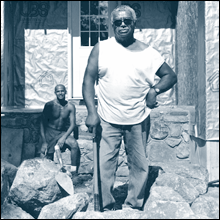![[Sidebar]](/standard/image/sidebar.gif)
![[Art Reviews]](/standard/image/headers/art_reviews_header.gif)
| galleries |
hot links |
museums |
reviews |
schools & universities |
Etched in stone
The art of masonry in words and images
by Bill Rodriguez
"Sonny" and Theodore Brown
When the last Ice Age receded 10,000 years ago, it left chaos in the form of stone and boulder debris around here. A thousand centuries later, despite our track record of messing up the environment, an agreeable order has been arranged here and there in the form of stone walls."Stone Walls of South County and Their Builders" is on display at the Museum of Natural History at Roger Williams Park through January 12. The 32 black-and-white photographs of walls and their makers are accompanied by remarks from most of the stone masons.
It's part folkloric, part esthetic, and part an exploration of the roots of cultures and myths. Those who take their time at this exhibition are not likely to keep driving by Rhode Island's omnipresent stone walls as casually as passing picket fences.
"There's something beyond the merely physical that enters into the walls. The walls are informed by all the history of those who have made them," said Marc Levitt, who initiated the project. He did so under a grant from Rhode Island 2000, a program that was pulling together the state's arts and humanities observances for the millennium. Joining him to create these striking images is a fellow South Kingstown resident, veteran photographer Mathias Oppersdorff.
Levitt, 50, is a storyteller best known locally as MC of the late, great Blue Bug Radio Cabaret and the New England Chowda Hour radio variety shows. His experience doing broadcast interviews came in handy in drawing out the explanations and observations recorded in text next to each photo. After growing up in New York City and living in San Francisco and Seattle before he moved to New England, stone walls were "quite revelatory" to him, Levitt noted.
"The way in which nature was part of Narragansett culture and the way in which some of the stone walls reflect the respect for nature was pretty unique," he said. "There's a deep spiritual, ecological component to the way in which many of the Native American builders approached their work."
Levitt was at the museum, surrounded by the exhibition. There is an Italian-American tradition of stone masonry in southern Rhode Island, which is represented here along with other wall builders of European background. But it is the Native American masons that seem to have most deeply captured Levitt's fascination.
The raw materials of stone masonry provide plenty of opportunities to display feats of strength and contests. In that way, notions of maleness have developed in tribal culture, Levitt said. For example, the late Ellison Meyers "Tarzan" Brown was as famous locally for exploits such as lifting huge stones as he was for winning both the 1936 and 1939 Boston Marathons.
Amid the images on the second floor of the museum is a picture of Tarzan's son, Ellison Meyers "Sonny" Brown, and his grandson Theodore, a third-generation stone wall maker.
Levitt stepped over to a corner of the room, to a portrait of Russell Spears, sitting serenely before one of his walls. To his right are studies of his son and grandson, standing next to their work.
Some of these photos show old walls by themselves, their makers unknown. But to the photographer who took them, those images are incomplete. "My favorite stone wall pictures are the ones with people, because I'm basically a people photographer. I wanted to capture the personalities who make these walls," said Mathias Oppersdorff, 64.
He has demonstrated that preference in such books of photographs as Adirondack Faces (1991) and People of the Road -- The Irish Travelers (1997). His pictures of nomadic Arabs, taken in the 1970s, will be published next spring by Syracuse University Press, titled Under the Spell of Arabia. In 1994, portraits closer to home were shown in a local exhibit, "South County Faces." Shifting his focus to food and travel, Oppersdorff has done the photography for 84 Gourmet magazine articles on places from Tuscany to Bangkok.
"I like preserving cultures that are disappearing," he noted. "These people, both the Native Americans and the non-Native Americans, are preserving a folk culture. They're doing it to make a living but meanwhile they're preserving stuff that's been going on for centuries."
Most of these photos had to be virtual snapshots, since the photographer was interrupting their work. Often he had less than a minute with a subject, who stepped over to where Oppersdorff had framed a shot before his 4x5-format camera on a tripod.
But with Levitt's interview experience and Oppersdorff's ability to get strangers to relax before a lens, the results were impressive.
It helped that the subject matter was men -- and one woman -- who tended to be grounded by their work figuratively as well as literally. That becomes clear if the last word is given to the patriarch of local Native American stone wall builders, 82-year-old Russell Spears, as he is quoted next to his portrait:
"I gotta be proud of what I do or I ain't going to do it. I would feel awful if I did a job and it didn't look right to me. It's not just a job. It's more than a job. Even now, if I drive by one of my walls and I see something wrong with it, I'd stop and fix it . . . When people say, `Oh, that looks good, Russell,' that makes a difference. It makes me feel better."
| home page |
what's new |
search |
about the phoenix |
feedback |
Copyright © 2000 The Phoenix Media/Communications Group. All rights reserved.
